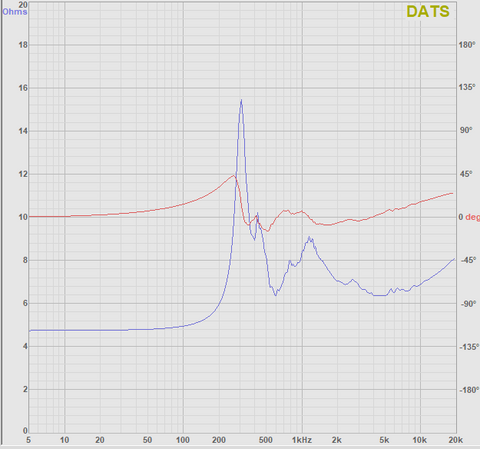Note: I've re-tested a new BMS driver and found that the test results in this blog post are suspect due to user error (damage) of the driver under test. The customer sent me a new driver from BMS and I've subsequently re-tested with the new driver and the results can be found here.
Check out my other blog posts by clicking HERE.
In this blog post I feature the BMS 4599HE (8 ohm version) Mid-Compression Driver on the ES290 Biradial horn No.1670. This driver was sent to me by my customer for evaluation. The driver is quite light at only 3.1Kg and quite small at only 133mm in diameter. At this time, the driver retails for €922.59 or $918.20 USD each.


The specification sheet for the BMS 4599HE can be found HERE.
My full test results can be found in the attached PDF HERE.
The BMS 4599HE has the following features:
- Dual 3.5” voice coils / annular diaphragms
- Perfect acoustical coupling
- Extremely high efficiency
- Exceptionally high power handling of 400 W (AES)
- Provides 6 dB more sound pressure than a comparable
- single voice coil driver
- Ultra low distortion
- Specially designed for extreme high output applications
- Neodymium Magnet Assembly
- Ultra light weight and small size
- 2x 8 Ohm or 2x 16 Ohm
The BMS stands out as a unique driver in that it uses two midrange diaphragms to improve overall output capability as well as sensitivity. As far as I am aware, this driver is unique in the market.
Objective Test Data
Below is the frequency response of the BMS 4599HE on the ES-290 Biradial.

The BMS produces a flat frequency response that is free from any irregulates in it's passband from 300Hz to 7kHz. It would not take much equalization to flatten the broad midrange hump centered around 1.4kHz.
The impedance response is shown below. The fundamental mechanical resonance is 300Hz.

This compares closely to the published impedance response shown below. BMS shows an FS of 220Hz however. The peak at 1200Hz on my graph is shown an octave lower at 600Hz on the published data. So it appears as though my driver may need some break in to loosen up a bit.

The step response is shown below. There appears to be some lingering decay after the initial impulse. Does the multiple driver configuration contribute to this? I am not sure. Generally we like to see a cleaner step response.

Burst decay shown below appears to be free from any serious resonances, even into the treble region at 7kHz.

The CSD plot shown below also reveals a clean performance. We can see the typical stored energy at the driver's FS of 300Hz.

Harmonic distortion is shown below with a test SPL of 90dB at 1 meter to start. This resulted in an output voltage at the amplifier of only 0.40 volts, equivalent to only 0.16 watts (160 milliwatts) of output.

Pushing the test SPL up to 95dB sees no increase in H2.
H3 and H4 lower as we leave the noise floor of the amplifier.

Increasing to 100dB is shown below. We now see a subtle rise in H2 with H3 and H4 being at the threshold of the measurement system.

Increasing to 105dB SPL is shown below. The driver is still happy with H2 only at 0.57%. This is the lowest distortion compression driver I've tested to date in terms of clean output in the 100dB + category. It should be noted that these are strictly concert levels of output, which is the design application for this driver.

Looking at intermodulation distortion we see that the driver is not the best I've measured. Distortion is very low in the lower midrange but things are about average in the midrange and lower treble region. IMD is -70dB in the 500Hz region, -62dB in the 2kHz region, and -55dB in the 5kHz region. Generally the best drivers I've tested do better than -65dB across the spectrum.

Increasing the test SPL to 95dB is shown below. We see distortion worsen in the 5kHz region to -50dB.

Increasing the test SPL to 100dB is shown below. 5kHz region is reduced again to -45dB, an average result.

Increasing the test SPL to 105dB is shown below. 5kHz region is reduced to -40dB (1%).

The BMS 4599HE clearly has a rising IM distortion characteristic in terms of output SPL. This contrasts to other tests with other drivers where IM distortion does not rise as output increases. This is simply because every driver has it's own unique non-linear function or characteristic. In a perfect world, we would like to see IM distortion remain low even up to it's maximum intended output SPL.
Is the BMS 4599HE suitable for home hifi applications? The driver exhibits a nice flat frequency response however we do see a somewhat compromised sound quality performance in the 5kHz region in my IM distortion test. It has been my experience that any driver suffering to this level is simply not suitable for home hifi. The dual diaphragm architecture does not seem to benefit in any way for those looking for the ultimate sound quality in a home environment. However, in a professional sound application the driver clearly would do excellent.
In an effort to ensure I've done my testing correctly, I installed an autoformer on the driver to attenuate the output by -18dB. My concern was that I was into the noise floor of the amplifier which may affect my results. I can report that the addition of the Autoformer had no impact on my test results for IM distortion. For reference, the amplifier used for this test was the Hypex FA501 which uses N-Core technology for ultra low distortion.